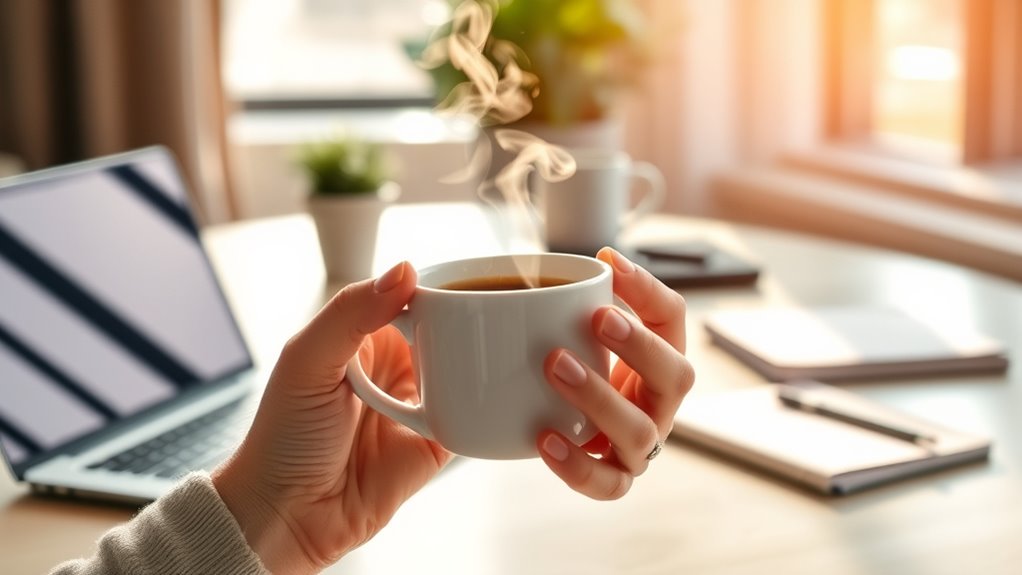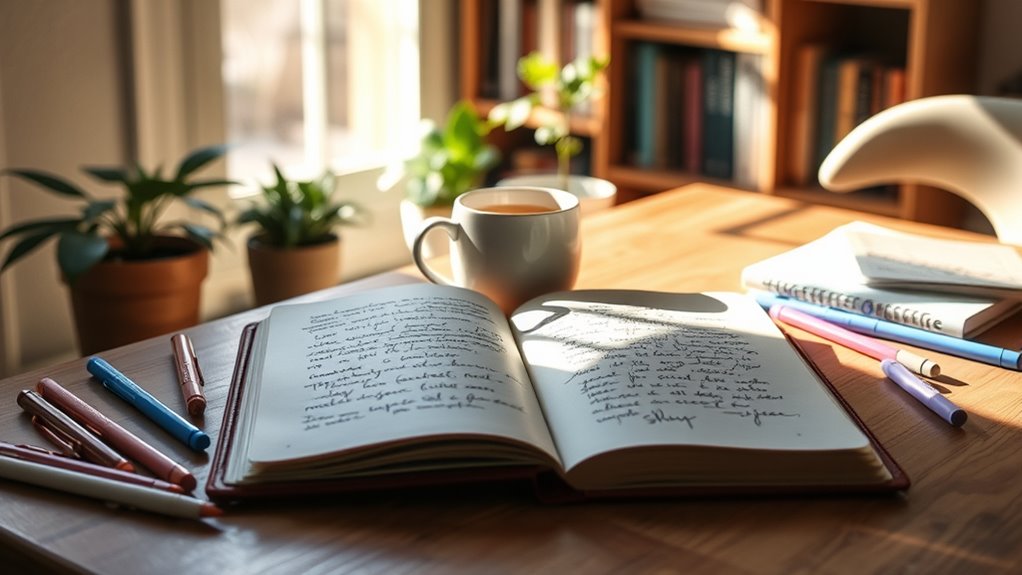Mindfulness & Well‑Being
Mindful Eating 101: Fully Tasting Your Life
Unlock the secrets of mindful eating and discover how fully tasting your life can transform your relationship with food and yourself.

Mindful eating invites you to fully taste and enjoy your food by paying close attention to each bite. As you slow down, notice the colors, smells, textures, and flavors that make your meal special. Focus on your body’s hunger and fullness cues, savoring the experience rather than rushing through it. This practice transforms mealtime into a moment of awareness and gratitude. Keep exploring, and you’ll discover how to make your eating more nourishing and satisfying.
Key Takeaways
- Practice paying full attention to your eating experience, noticing colors, smells, textures, and flavors.
- Decide on reasonable portions beforehand and use smaller dishes to control intake mindfully.
- Chew slowly and focus on textures to deepen sensory enjoyment and satisfaction.
- Turn meals into moments of gratitude, reducing guilt and emotional eating.
- Reconnect with your body’s hunger and fullness cues for healthier, more fulfilling eating habits.

Mindful eating invites you to pay full attention to the experience of eating, helping you become more aware of your body’s hunger and fullness cues. When you focus on what you’re eating, you’re less likely to overeat or rush through your meals without truly experiencing them. Instead, you slow down, notice the colors, smells, and tastes of your food, and connect with the act of nourishing yourself. One practical way to do this is through mindful portioning. Rather than serving yourself large amounts automatically, take a moment to decide what a reasonable portion looks like for you. Use smaller plates or bowls to help control your servings, and remind yourself that you can always get seconds if you’re still hungry. This approach encourages you to listen to your body’s signals, preventing overeating while still satisfying your hunger.
Practice mindful portioning by choosing reasonable servings and listening to your body’s hunger signals.
As you eat more mindfully, you’ll find yourself savoring textures more intentionally. Instead of rushing through a bite, take the time to notice how your food feels — whether it’s the crunchiness of fresh vegetables, the creaminess of yogurt, or the chewiness of bread. Savor each texture by chewing slowly and paying attention to the sensation in your mouth. This not only enhances your enjoyment but also deepens your awareness of what you’re eating. When you truly taste and appreciate the textures, you’re more likely to feel satisfied with less food. It’s a simple but powerful way to turn a routine meal into a moment of mindfulness and gratitude.
Practicing mindful portioning and savoring textures can also help you develop a healthier relationship with food. Instead of viewing certain foods as forbidden or indulgent, you start to see eating as an opportunity to experience pleasure and nourishment simultaneously. This shift reduces guilt and emotional eating, making mealtime more fulfilling. As you become more aware of your hunger cues and your enjoyment of different textures, you’ll naturally start to prioritize quality over quantity. Over time, these mindful habits can lead to better digestion, improved energy levels, and a greater sense of satisfaction from your meals.
Additionally, integrating mindfulness into your eating habits can support your awareness of data privacy challenges and help you make more informed choices about the foods you consume and how you consume them. Ultimately, mindful eating isn’t about perfection; it’s about cultivating awareness and appreciation for every bite. By practicing mindful portioning and savoring textures, you take control of your eating habits and reconnect with your body’s needs. You’ll find that meals become more enjoyable, more nourishing, and more aligned with your overall well-being. It’s a small change that can have a big impact on your relationship with food and your life.
Frequently Asked Questions
How Quickly Should I Eat to Practice Mindfulness Effectively?
You should eat slowly enough to notice your eating pace and stay attuned to hunger awareness. Taking small bites and pausing between bites helps you savor each flavor and recognize when you’re full. Rushing can lead to overeating, so aim for a relaxed pace that allows you to fully experience your food. This mindful approach enhances your connection to your body’s signals and promotes healthier eating habits.
Can Mindful Eating Help With Emotional Eating?
You might find that mindful eating helps with emotional eating by increasing your emotional awareness. When you pay attention to your hunger cues and how food makes you feel, you can better recognize emotional triggers. This practice also promotes stress reduction, helping you manage emotions without turning to food for comfort. Over time, mindful eating encourages healthier responses, reducing emotional eating and fostering a more balanced relationship with food.
What Are Common Challenges When Starting Mindful Eating?
Ever feel like your habits are running wild? Starting mindful eating can be tricky, especially with challenges like maintaining portion control and resisting impulsive mindful snacking. You might find it hard to slow down or stay present during meals. These hurdles can make the journey feel overwhelming, but with patience and practice, you’ll learn to recognize hunger cues and enjoy each bite, transforming your eating experience step by step.
How Does Mindful Eating Impact Digestion and Metabolism?
Mindful eating helps improve digestion and metabolism by making you more aware of your body’s signals. When you focus on your food, you naturally practice portion control, which prevents overeating. This attentiveness allows your body to better break down food, enhancing nutrient absorption. As a result, your metabolism becomes more efficient, supporting overall health. You’ll notice improved energy levels and digestion when you pause and savor each bite.
Is Mindful Eating Suitable for Children and Teenagers?
You might wonder if mindful eating suits children and teenagers. It’s actually beneficial, as it helps improve children’s nutrition and encourages healthier teenager eating habits. By teaching them to pay attention to hunger cues and savor their food, you support better digestion and reduce overeating. Incorporating mindful eating into their routines fosters awareness, promotes balanced choices, and builds lifelong healthy habits, making it a valuable practice for young people.
Conclusion
By embracing mindful eating, you open a world where every bite transforms into a profound experience. When you truly taste your food and savor each moment, you’ll find life’s simplest pleasures become extraordinary—like discovering a hidden treasure in every meal. Remember, this practice isn’t just about eating; it’s about awakening your senses to a richer, more vibrant life. So, take your time, and let each meal be a reminder that you’re worthy of true nourishment and joy.
Mindfulness & Well‑Being
The Power of Micro‑Breaks: 2 Minutes to Reset Your Brain
The power of micro-breaks can transform your productivity—discover how just two minutes can reset your mind and boost your focus.

Taking just two minutes for a micro-break can substantially boost your focus and reduce stress. By pausing, stretching, or practicing mindfulness, you reset your brain, lower cortisol levels, and improve circulation. These quick breaks help prevent burnout and keep your energy levels steady. Incorporating intentional pauses into your routine transforms busy workdays into moments of renewed clarity. Want to discover more simple techniques to maximize your productivity and mental clarity? Keep exploring to reveal the full potential of micro-breaks.
Key Takeaways
- Micro-breaks of about two minutes help reset mental focus and reduce fatigue, enhancing overall productivity.
- Short pauses promote mindfulness techniques like deep breathing, lowering stress hormones and improving circulation.
- Regular micro-breaks prevent burnout by breaking up prolonged work sessions and maintaining motivation.
- Consistent two-minute breaks clear mental clutter, sharpen attention, and sustain energy levels throughout the day.
- Incorporating intentional micro-breaks transforms busy routines into energized, focused work periods, boosting efficiency.

Have you ever wondered how a quick pause can boost your productivity? It might seem counterintuitive, but taking brief micro-breaks throughout your workday can make a significant difference. These tiny pauses, often lasting just two minutes, allow you to reset your brain and refocus your energy. Incorporating mindfulness techniques during these moments can amplify their benefits, helping you stay present and reduce stress. When you intentionally pause, you’re practicing a form of mindfulness that clears mental clutter, sharpens your focus, and increases your overall efficiency.
Think of these micro-breaks as essential productivity hacks—tiny strategies that can transform how you approach your tasks. Instead of pushing through fatigue or distraction, giving yourself permission to step away briefly can prevent burnout and maintain your motivation. During these two-minute intervals, you can stretch, breathe deeply, or even close your eyes for a moment. These simple actions can lower cortisol levels, improve circulation, and boost mental clarity. The key is to be intentional about how you use this time. Instead of scrolling through your phone or zoning out, engage in mindfulness techniques like focused breathing or body scans. These practices help you anchor your attention to the present moment, reducing mental chatter and anxiety.
Micro-breaks boost focus and reduce stress with simple mindfulness practices—your secret weapon against burnout.
Scheduling regular micro-breaks is one of the easiest productivity hacks to implement. Set alarms or timers to remind yourself to pause every hour or so. When the alarm rings, resist the urge to check emails or social media. Instead, step away from your workspace and do a quick mindfulness exercise—like inhaling slowly for four seconds, holding your breath, then exhaling completely. This simple act can re-energize your mind and body, making it easier to tackle the next set of tasks with renewed focus. You’ll notice that with consistent practice, these brief pauses become natural parts of your workflow, helping you sustain high levels of concentration without exhaustion.
Ultimately, micro-breaks aren’t just about resting—they’re strategic moments that enhance your productivity. By leveraging mindfulness techniques during these short intervals, you create a mental reset that sharpens your attention and reduces stress. These small, intentional pauses serve as powerful productivity hacks, transforming a busy workday into a series of energized, focused moments. Incorporating color accuracy and contrast ratio improvements into your workspace can also significantly boost your visual comfort and focus during long work sessions. So next time you’re feeling overwhelmed or stuck, remember that just two minutes can be enough to refresh your mind, boost your efficiency, and keep you moving forward with clarity.
Frequently Asked Questions
Can Micro-Breaks Improve Long-Term Productivity?
Micro-breaks can definitely improve your long-term productivity. When you take just two minutes to do mindfulness exercises or physical stretching, you give your brain a much-needed reset. These quick pauses reduce fatigue, boost focus, and enhance mental clarity. By regularly incorporating micro-breaks into your routine, you create healthier work habits, leading to sustained performance and better overall efficiency over time.
Are Micro-Breaks Effective During High-Pressure Tasks?
During high-pressure tasks, micro-breaks can be highly effective in your work environment. Short, 2-minute breaks help you reset your focus and reduce stress, preventing burnout. Keep in mind that break duration matters; quick pauses allow your brain to recover without losing momentum. Incorporating these brief pauses into your routine can boost overall productivity and mental clarity, especially when you’re tackling demanding, high-stakes projects.
What Activities Are Best During a 2-Minute Break?
Your 2-minute break can be a game-changer for your productivity. During this time, you should do stretching exercises to loosen tight muscles and boost circulation. Pair this with mindfulness techniques, like deep breathing or quick meditation, to clear your mind. These activities are highly effective, almost like hitting a reset button for your brain, helping you return to work refreshed, focused, and ready to conquer any challenge.
How Often Should Micro-Breaks Be Taken?
You should take micro-breaks every hour to maintain focus and prevent fatigue. During these 2-minute pauses, incorporate stretching routines to loosen muscles and improve circulation. Keep hydration tips in mind by drinking water to stay alert. Regular micro-breaks help reset your brain, boost productivity, and reduce stress, making your work more efficient and comfortable. Remember, consistency is key to recharging effectively throughout your day.
Do Micro-Breaks Benefit Mental Health Beyond Productivity?
Did you know that taking micro-breaks can boost mental health beyond just increasing productivity? These brief pauses allow you to practice mindfulness exercises, reducing stress and enhancing focus. They also encourage social interactions, which improve mood and emotional well-being. By consistently incorporating micro-breaks into your day, you support mental resilience and foster healthier habits, making your overall mental health stronger and more balanced.
Conclusion
So there you have it—just two minutes of pretending to stretch or stare out the window can magically transform your productivity. Who knew that tiny, almost embarrassing breaks could unlock your genius? Next time you’re feeling stuck, remember: a micro-break might just be your secret weapon against drudgery. Or, you know, you could just keep working and hope caffeine saves the day. Your call. Either way, your brain will thank you… probably.
Mindfulness & Well‑Being
Journaling for Emotional Clarity: Prompts Backed by Therapists
By exploring therapist-backed journaling prompts, you can unlock emotional clarity and discover insights that may transform your inner world.

Journaling with therapist-backed prompts can help you gain emotional clarity by encouraging honest reflection and deeper insight into your feelings. Prompts like “What am I feeling right now, and why?” guide you to identify triggers, recognize patterns, and process emotions safely. This ongoing practice increases self-awareness, improves emotional regulation, and fosters personal growth. Keep exploring, and you’ll discover how structured journaling can transform your understanding of your inner world.
Key Takeaways
- Therapist-backed prompts guide honest self-reflection, uncover emotional patterns, and deepen understanding of personal triggers.
- Using specific questions like “What am I feeling right now, and why?” enhances emotional awareness.
- Regular journaling with these prompts fosters emotional clarity, regulation, and personal growth.
- Prompts encourage confronting uncomfortable truths safely, building self-awareness and resilience.
- Incorporating therapist-approved prompts improves mindfulness and helps manage turbulent emotions effectively.

Journaling is a powerful tool that can help you gain emotional clarity by allowing you to process your thoughts and feelings openly. When you sit down to write, you create a safe space for self reflection, giving you the chance to explore what’s really going on inside. This process helps you develop emotional awareness, making it easier to recognize patterns, triggers, and underlying feelings that might otherwise stay hidden. As you journal regularly, you begin to notice how certain events impact your mood and behavior, helping you build a clearer understanding of your emotional landscape. This heightened awareness is essential for managing your emotions effectively and fostering personal growth.
Using specific prompts backed by therapists can guide you toward deeper self reflection and emotional insight. For example, you might start by asking yourself, “What am I feeling right now, and why?” This simple question encourages you to identify your emotions without judgment, which is a key step in emotional awareness. Another useful prompt could be, “What recent situation triggered a strong emotional response, and how did I handle it?” This helps you connect specific experiences to your emotional reactions, revealing patterns that you can work on. Additionally, understanding the importance of contrast ratio in visual perception can help you recognize how clarity in your emotional awareness enhances your overall well-being. By consistently engaging with these kinds of prompts, you create a habit of examining your inner world, leading to greater clarity and self understanding.
Therapists often recommend journaling as a way to process complex feelings and gain perspective. They suggest that you don’t need to censor yourself—be honest and open. This honesty deepens your self reflection and allows you to confront uncomfortable truths in a safe environment. As you become more familiar with your emotional patterns, you’ll notice what causes stress, joy, or frustration. This awareness empowers you to make more intentional choices and respond to situations with greater mindfulness. Over time, journaling becomes a tool for emotional regulation, helping you stay grounded during turbulent moments.
Frequently Asked Questions
How Often Should I Journal for Emotional Clarity?
You might wonder about journaling frequency for emotional benefits. To gain clarity, try journaling daily or a few times a week—consistent practice helps process feelings and track your growth. There’s no one-size-fits-all, so listen to your needs. Regular journaling enhances emotional awareness, reduces stress, and boosts mood. Experiment with different routines to find what feels best, making journaling a supportive part of your emotional well-being.
Can Journaling Replace Therapy Sessions?
Some believe journaling can replace therapy, but self-reflection techniques like journaling have limitations. While it helps clarify emotions and track progress, it lacks the personalized guidance and deep insight a therapist provides. Journaling supports mental health but isn’t a substitute for professional help when facing complex issues. Use it as a complementary tool, not a full replacement, to ensure thorough emotional support and growth.
What if I Feel Overwhelmed by My Journal Entries?
If you feel overwhelmed by your journal entries, it’s important to recognize emotional overload and set clear journaling boundaries. Take a break or limit your writing time to avoid intensifying feelings. Practice self-compassion and remember that journaling is a tool, not a solution. If overwhelm persists, consider talking to a therapist for guidance. Prioritize your mental health and adjust your journaling habits to support your emotional well-being.
Are There Specific Journal Tools Recommended by Therapists?
Think of journal tools like a trusty toolbox for your mind. Therapists often recommend specific tools such as guided journals, digital apps, or prompts that help you stay focused and organized. These tools act as your map, guiding you through emotional terrain. By using therapist-recommended journal tools, you create a safe space to explore feelings and gain clarity without feeling overwhelmed. They make your journaling journey smoother and more effective.
How Long Does It Typically Take to See Emotional Benefits?
You might wonder how long it takes to see emotional benefits from journaling. Typically, with consistent practice, you’ll notice improvements in emotional resilience within a few weeks to a couple of months. The key is journaling consistency; the more regularly you write, the faster you’ll build clarity and strength. Keep at it, and over time, you’ll likely experience a greater sense of emotional balance and resilience.
Conclusion
Think of journaling as a flashlight guiding you through a dark, tangled forest. Each prompt illuminates hidden emotions and sheds light on your true feelings, helping you find clarity amid confusion. As you write regularly, you’ll carve clear paths through emotional chaos, making it easier to understand yourself. Keep shining that light—your journal is your map, leading you toward self-awareness and peace. Trust the process, and let your words illuminate your way.
Mindfulness & Well‑Being
Sleep Hygiene Hacks for High Achievers
Harness powerful sleep hygiene hacks for high achievers to unlock optimal rest—discover the secrets that could transform your nightly routine.

To boost your sleep hygiene as a high achiever, establish a consistent bedtime routine with calming activities like warm baths or gentle stretches, and avoid screens before bed to reduce blue light exposure. Create a sleep-friendly environment by keeping your room cool, dark, and quiet, while using comfortable bedding. Stick to regular sleep schedules, even on weekends, to anchor your internal clock. Keep exploring for more tips to optimize your rest and enhance your success.
Key Takeaways
- Establish a consistent bedtime routine with calming activities like reading or gentle stretches to signal your body to relax.
- Limit screen exposure before bed to reduce blue light interference and promote melatonin production.
- Optimize your sleep environment by keeping it cool, dark, and quiet for better rest and dream quality.
- Stick to a regular sleep schedule, even on weekends, to maintain your internal clock and improve sleep efficiency.
- Incorporate relaxation techniques such as meditation or deep breathing to reduce stress and enhance sleep onset.

Getting quality sleep is essential for your health, but many people struggle to achieve it. High achievers often push themselves too hard, making it even harder to wind down at night. One effective way to improve your sleep hygiene is by focusing on dream relaxation. Creating an environment that promotes peaceful dreams can make a significant difference. This involves limiting exposure to screens before bed, as the blue light emitted can interfere with your melatonin production, delaying sleep onset. Instead, opt for calming activities like reading a book, listening to soothing music, or practicing gentle stretches. These habits help ease your mind and prepare it for restful sleep, making your dreams more restorative.
Prioritize dream relaxation by limiting screens and engaging in calming activities for more restorative sleep.
Another crucial aspect is establishing consistent bedtime routines. When you follow a set schedule, your body learns to anticipate sleep, which can improve its ability to fall asleep faster and stay asleep longer. Start winding down at the same time every evening, allowing your body to transition smoothly from wakefulness to rest. Incorporate relaxing activities such as a warm bath, meditation, or light stretching into your routine. These actions signal to your brain that it’s time to relax, reducing stress levels and promoting a sense of calm. Avoid stimulating activities, like intense workouts or work-related tasks, close to bedtime, as they can elevate your alertness and delay sleep.
Your environment also plays a vital role in supporting dream relaxation and effective bedtime routines. Keep your bedroom cool, dark, and quiet to foster an ideal sleep setting. Invest in blackout curtains or a sleep mask to block out light and use earplugs or white noise machines to minimize disruptions. Your bed should be comfortable, with supportive pillows and a quality mattress that suits your preferences. When your environment is conducive to sleep, your body can relax more easily, making it simpler to stick to your bedtime routines and enjoy better dream quality. Additionally, understanding the importance of contrast ratio in projectors can help you create a relaxing visual environment if you enjoy watching movies before bed, as higher contrast ratios contribute to more immersive and comfortable viewing experiences.
Consistency is key. Stick to your routines even on weekends, as irregular sleep schedules can throw off your internal clock. Over time, these habits become automatic, making it easier to fall asleep quickly and wake up refreshed. Remember, prioritizing dream relaxation and a set bedtime routine isn’t just about getting enough sleep; it’s about improving the quality of your rest. When your sleep improves, so does your focus, mood, and overall productivity. High achievers like you need to protect your sleep as a *crucial* part of your success strategy.
Frequently Asked Questions
How Does Stress Impact Sleep Quality for High Achievers?
Stress can markedly lower your sleep quality by triggering your body’s fight-or-flight response, making it hard to unwind. When you don’t manage stress well, it disrupts your sleep environment, causing difficulties falling or staying asleep. Prioritizing stress management techniques and optimizing your sleep environment helps you relax, leading to more restorative sleep. High achievers should focus on calming routines to reduce stress and improve overall sleep quality.
Can Diet Choices Improve Sleep Hygiene Effectively?
Ever wondered if your diet choices can boost your sleep? Absolutely. By paying attention to meal timing, you prevent discomfort that can disrupt rest, and maintaining good hydration habits avoids waking up thirsty. Choosing sleep-friendly foods rich in magnesium and tryptophan can also promote relaxation. You’re in control—adjust your diet, and you’ll likely see a noticeable improvement in your sleep quality. Wouldn’t you want to sleep better tonight?
What Are Quick Relaxation Techniques Before Bedtime?
You want quick relaxation techniques before bedtime? Try guided breathing to calm your mind and slow your heart rate. Focus on deep, slow inhales and exhales to relax your body. Additionally, practice progressive relaxation by tensing and releasing muscle groups, starting from your toes up. These methods help you unwind swiftly, making it easier to fall asleep and improve your overall sleep quality.
How Does Caffeine Consumption Affect Sleep for Professionals?
Imagine the quiet of your night shattered by unexpected wakefulness—that’s the impact of caffeine dependency. Consuming caffeine too late can cause significant sleep disruption, making it harder for you to fall asleep and stay asleep. Even small amounts can interfere with your rest, leaving you tired and less focused. For high achievers, understanding how caffeine affects sleep is vital; it’s a secret that can either boost your productivity or sabotage your success.
Are Sleep Trackers Reliable for High Achievers?
Sleep tracking can be helpful for high achievers, but you should be cautious about relying solely on these devices. Their data accuracy varies, and some may misinterpret rest or wake periods. You’ll get useful insights, but don’t ignore how you feel during the day. Use sleep tracking as a guide, not gospel, and combine it with other signs of good sleep to optimize your rest and performance.
Conclusion
By implementing these sleep hygiene hacks, you’ll set yourself up for better rest and higher productivity. Imagine Sarah, a busy executive, who started winding down an hour earlier and noticed her focus and energy improved dramatically. Small changes like establishing a consistent bedtime or avoiding screens can make a big difference. Prioritize your sleep, and watch how your high-achieving potential soars — because when you rest well, you perform better.
-

 Wish Notes1 year ago
Wish Notes1 year agoBest Caption to Wish Myself a Happy Birthday That Everyone Will Like!
-

 Wish Notes1 year ago
Wish Notes1 year agoThe Best Birthday Wishes to Make Your Uncle's Day Bright!
-

 Wish Notes1 year ago
Wish Notes1 year agoThe Sweetest Happy Birthday Wishes for Your Wife!
-

 Wish Notes1 year ago
Wish Notes1 year agoThe Best Happy Birthday Wish for Your Brother That Will Make Him Smile!
-

 Wish Notes1 year ago
Wish Notes1 year agoHeartwarming Birthday Messages for Mom in Spanish
-

 Wish Notes1 year ago
Wish Notes1 year agoThe Best Happy Birthday Wishes for Your Husband That Will Make His Day!
-

 Wish Notes1 year ago
Wish Notes1 year agoThe Ultimate Birthday Wishes to Celebrate Yourself!
-

 Wish Notes1 year ago
Wish Notes1 year agoThe Most Heartfelt Good Night Wishes Ever!























